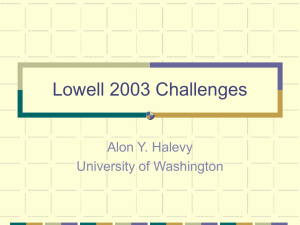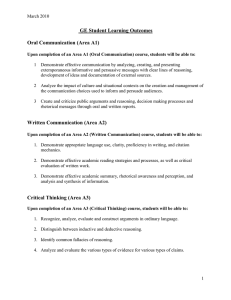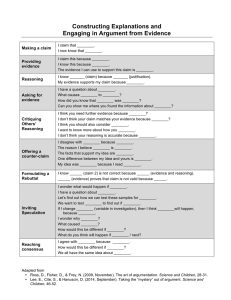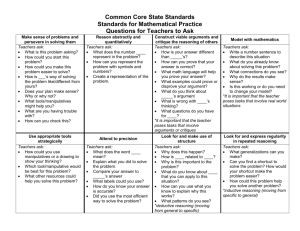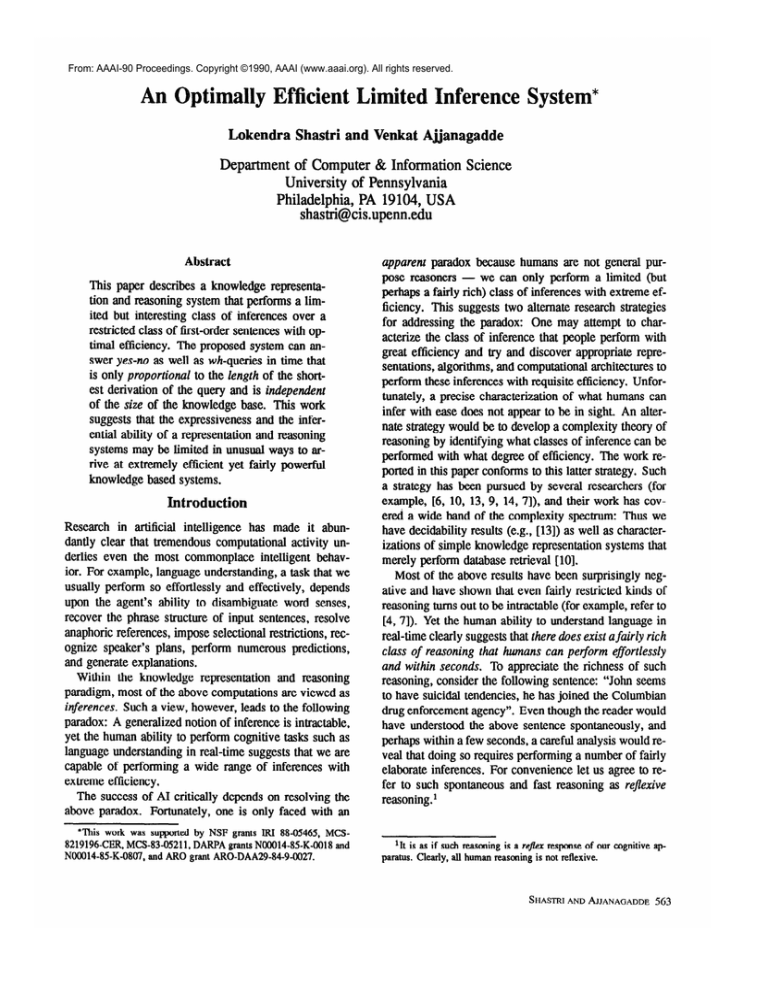
From: AAAI-90 Proceedings. Copyright ©1990, AAAI (www.aaai.org). All rights reserved.
ptimally Efficient
Inference Syste
Lokendra Shastri and Venkat Ajjanagadde
Department of Computer & Information Science
University of Pennsylvania
Philadelphia, PA 19104, USA
shastri@cis.upenn.edu
Abstract
This paper describes a knowledge representation and reasoning system that performs a limited but interesting class of inferences over a
restricted class of first-order sentences with optimal eticiency. The proposed system can answer yes-no as well as w/z-queries in time that
is only proportional to the Zength of the shortest derivation of the query and is independent
of the size of the knowledge base. This work
suggests that the expressiveness and the inferential ability of a representation and reasoning
systems may be limited in unusual ways to arrive at extremely efficient yet fairly powerful
knowledge based systems.
Introduction
Research in artificial intelligence has made it abundantly clear that tremendous computational activity underlies even the most commonplace intelligent behavior. For example, language understanding, a task that we
usually perform so effortlessly and effectively, depends
upon the agent’s ability to disambiguate word senses,
recover the phrase structure of input sentences, resolve
anaphoric references, impose selectional restrictions, recognize speaker’s plans, perform numerous predictions,
and generate explanations.
Within the knowledge representation and reasoning
paradigm, most of the above computations are viewed as
inferences. Such a view, however, leads to the following
paradox: A generalized notion of inference is intractable,
yet the human ability to perform cognitive tasks such as
language understanding in real-time suggests that we are
capable of performing a wide range of inferences with
extreme efficiency.
The success of AI critically depends on resolving the
above paradox. Fortunately, one is only faced with an
*This work was supported by NSF grants IRI 88-05465, MCS8219196-CER, MCS-83-05211, DARPA grants NOOO14-85-K-0018 and
NOOO14-85-K-0807, and AR0 grant ARO-DAA29-84-9-0027.
apparent paradox because humans are not general pur-
pose reasoners - we can only perform a limited (but
perhaps a fairly rich) class of inferences with extreme efficiency. This suggests two alternate research strategies
for addressing the paradox: One may attempt to characterize the class of inference that people perform with
great efficiency and try and discover appropriate representations, algorithms, and computational architectures to
perform these inferences with requisite efficiency. Unfortunately, a precise characterization of what humans can
infer with ease does not appear to be in sight. An alternate strategy would be to develop a complexity theory of
reasoning by identifying what classes of inference can be
performed with what degree of efficiency. The work reported in this paper conforms to this latter strategy. Such
a strategy has been pursued by several researchers (for
example, [6, 10, 13, 9, 14, 7]), and their work has covered a wide band of the complexity spectrum: Thus we
have decidability results (e.g., [13]) as well as characterizations of simple knowledge representation systems that
merely perform database retrieval [lo].
Most of the above results have been surprisingly negative and have shown that even fairly restricted kinds of
reasoning turns out to be intractable (for example, refer to
[4, 71). Yet the human ability to understand language in
real-time clearly suggests that there does exist a fairly rich
class of reasoning that humans can perform effortlessly
and within seconds. To appreciate the richness of such
reasoning, consider the following sentence: “John seems
to have suicidal tendencies, he has joined the Columbian
drug enforcement agency”. Even though the reader would
have understood the above sentence spontaneously, and
perhaps within a few seconds, a careful analysis would reveal that doing so requires performing a number of fairly
elaborate inferences. For convenience let us agree to refer to such spontaneous and fast reasoning as reflexive
reasoning. l
lit is as if such reasoning is a rejlex response of our cognitive apparatus. Clearly, all human reasoning is not reflexive.
SHASTRIANDAJJANAGADDE
563
In evaluating the complexity of reflexive reasoning it
must be recognized that such reasoning is performed with
reference to an extremely large body of knowledge. We
believe that a conservative estimate of the number of
‘rules’ and ‘facts’ required to encode all relevant aspects
of the domain of common sense will easily run into several million (perhaps, even more).2 In view of the above
it appears that the time complexity of an inference algorithm for reflexive reasoning should at worst be sublinear
in IKBI - where lK.Bl is the size of the knowledge base
- and perhaps even be independent of IKBI.
Reflexive reasoning inhoduces a very strong notion of
effectiveness, one that seems formidable in view of the
negative results cited above. In this paper we report an
encouraging result. We identify a class of inference that
is computable in time that is not only sublinear in IKB I
but is also, in a sense, optimal. We describe a knowledge
representation and reasoning system that can encode a restricted class of first-order sentences and answer a class
of queries in time that is only proportional to the length
of the shortest derivation of the query and is independent
of IK B I. This work suggests that there exist interesting
points in the tradeoffcontinuum between computational
effectiveness and inferential/expressive power. It also
demonstrates that it is possible to arrive at extremely efficient yet fairly powerful knowledge representation systems by explicitly recognizing the symbiotic relationship
that exists between expressiveness, effectiveness of inference, the choice of representation (data-structures), and
the underlying model of computational.
Functional Specification
The knowledge representation system encodes rules and
facts of the following form:
VXl, .. .. x, [Pl(...)AP2( . ..)...AP.(...)
=s 321, ...q Q(...)]
yes-no question. On the other hand, a query with existentially quantified variables corresponds to a wh-query and
answering such a query involves findings variable binding(s) for which the query follows from the rules and
facts encoded in the system.
It can be shown that the knowledge representation sysds soundly provided a query satisfies the following conditions:3
1. The number of distinct constants specified in the
query does not exceed 0, where Q is an implementation parameter (see Section 3).
2. Any rule that participates in the derivation of the
query must obey the following constraint: Any variable occurring in multiple argument positions in the
antecedent of such a rule must get bound during the
reasoning process (this, via backward chaining).
3. During the processing of the query, each predicate
may only be instantiated with one set of argument
bindings. This restriction, however, only applies to
run-time or ‘dynamic’ instantiations of predicates
and not to ‘long-term’ facts stored in the system.
Recently, we have extended the system to allow it
to represent up to Ic - where k is a system parameter
- dynamic instant&ions of each predicate during the
processing of a query [l 11. (This extension is not
discussed in this paper.)
If the above conditions are met, the system answers
yes to all yes-no queries that follow from the encoded
rules and facts in time proportional to the length of the
shortest derivation of the query. The system obeys the
closed world assumption and produces a IU) answer in
time proportional to d, where d equals the diameter of
the inferential dependency graph associated with the rulebase (see Section 3). wh-queries are also answered in time
proportional to d. Finally, the space complexity of the
system is just linear in IKBI.
The arguments of Pi’s are elements of {x1, x2, ...xm}.
An argument of Q is either an element of {x1, x2, . ..x.),
or an element of (zl , z2 , ...z~). or a constant. It is required that any variable occurring in multiple argument
positions in the antecedent of a rule must also appear in
its consequent.
Facts are assumed to be partial or complete instantiations of predicates. Thus facts are atomic formulae of
the form P(t1,t2...tk) where ti’s are either constants or
distinct existentially quantified variables.
A query has the same form as a fact. A query all of
whose arguments are bound to constants, corresponds to a
Reflexive reasoning takes place with reference to a large
body of knowledge and even though each reasoning
episode may involve a large number of rules and facts,
there is considerable psychological evidence to suggest
that most cognitive tasks performed efficiently without
props involve only a small number of distinct entities. A
reasonable estimate of the maximum number of distinct
entities we can deal with at a time is around seven [12].
It must be emphasized that the limit is on the number of
distinct entities and not on the number of variable (i.e.,
2Thoxpe and Imbert [16] argue that even the number of visually
identifiable entities is around a hundred thousand1
3The system is incomplete and the above conditions characterize its
incompleteness.
564
KNOWLEDGEREPRESENTATION
Cognitive Significance
role) bindings that these entities participate in during an
episode of reasoning. We believe that the first condition
listed in the previous section is consistent with this aspect
of human reasoning and a psychologically plausible value
of Q may be around seven.
We also conjecture that any given episode of reflexive reasoning does not require the same predicate to be
dynamically instantiated more than k: times, where a psychologically plausible value of k may be as low as three
to five (observe that k greater than 1 allows for bounded
recursion). Thus the third limitation of the reasoning system is also well motivated.
In our view, the KB underlying reflexive reasoning primarily encodes an agent’s long-term and stable knowledge about the world. Although new rules do get added
to an agent’s KB, the assimilation of a new rule in a
form that allows its participation in reflexive reasoning
takes time - not seconds, but perhaps minutes, days or
even months. It is in this context that one must evaluate
the realization of the reasoning system described below.
Finally, the realization of the reasoning system is also
biologically plausible in that it strictly adheres to the core
features of the connectionist model. At the same time,
there exists neurophysiological evidence to suggest that
the basic mechanisms used below, namely, the propagation of rhythmic patterns of activity, play a role in the
representation and processing of information in the animal brain. For a detailed discussion, refer to [ 13.
ealization of the Reasoning System
The representation and reasoning system is realized as a
massively parallel network of simple processing elements
(nodes). A major technical problem that must be solved
in realizing such a ‘connectionist’ reasoning system is the
run-time (dynamic) creation and propagation of variable
bindings. The proposed system solves this problem while
still using extremely simple oscillatory nodes (see next
section).
Ballard [2] was the first to propose a massively parallel
inference system. He however, required that all possible
variable bindings be explicitly pre-wired into a network.
This requirement is too severe and unrealistic and greatly
limits the generality of his system. Touretzky and Hinton’s DCPS does represent dynamic bindings [17] but its
ability to do so is very limited. First, DCPS can only deal
with single variable rules. Second, even though DCPS is
a parallel system, it allows only one rule to fire at a time,
and hence, does not satisfy the efficiency requirements of
reflexive reasoning. A detailed comparison of our system with other massively parallel reasoning systems (for
example, ROBIN, CONPOSIT, and NETL [8,3,5]) may
he found in [15].
Conceptually, the proposed encoding of the knowledge
base amounts to creating a directed ir#erential dependency
graph: Each predicate argument is represented by a node
in this graph and each rule is represented by links from
nodes denoting the arguments of the consequent predicate
to nodes denoting the arguments of the corresponding antecedent predicate. Facts are small networks attached to
their respective predicates nodes. We describe the encoding with the help of an example. For simplicity we only
describe the realization of single antecedent rules without constants and existentially quantified variables in the
consequent.
Fig. 1 illustrates the encoding of the following facts
and rules.
1. Vx, Y, z [give@, Y, z) * own(y, %)I
2.
3.
4.
5.
6.
k Y bY(X, Y) 3 own(x, Y)l
Vx, y [own(x, y) * can-sell(x, y)]
give( John, Mary, Bookl)
buy( John, x)
own( Mary, Balll)
The encoding makes use of two types of nodes. These
are p-btu nodes (depicted as circles) and r-and nodes
(depicted as pentagons). The computational behavior of
these nodes is as follows:
A p-btu is a phase-sensitive binary threshold unit.
When such a node becomes active, it produces an oscillatory output in the form of a pulse train that has a
period x and pulse width W. The timing (or the phase)
of the pulse train produced by a p-btu node is precisely
governed by the phase of the input to the node. A r-and
node acts like a temporal and node. Such a node also
oscillates with the same frequency as a p-btu node except
that it becomes active only if it receives uninterrupted
activation over a whole period of oscillation. Furthermore, the width of the pulses produced by a T-and node
equals ?r. The implementation parameter Q that governs
the maximum number of distinct entities that may participate in the derivation of a yes-no query equals w/n
(assume integer divide).
The output pulse of a node propagates along every link
emanating from the node. The encoding also makes use
of inhibitory mod@ers. An inhibitory modifier is a link
that impinges upon and inhibits another link. Thus a
pulse propagating along an inhibitory modifier will block
the propagation of a pulse propagating along the link it
impinges upon. In Fig. 1, inhibitory modifiers arc shown
as links ending in dark blobs.
Each constant in the domain is encoded by a p-node.
An n-q predicate is encoded by a pair of r-and nodes
and n p-btu nodes, one for each of the n arguments. One
of the T-and nodes is referred to as the enabler and the
other as the collector. As a matter of convention, an enabler always points upwards and is named e:[predicatename]. A collector always points downwards and is
named c:[predicate-name].
SHASTRI AND AJJANAGADDE
565
I I
John
0
Mary
0
Book1
Ball1
0
0
Figure 1: An example encoding of rules and facts
A rule is encoded by connecting the collector of the
antecedent predicate to the collector of the consequent
predicate, the enabler of the consequent predicate to the
enabler of the antecedent predicate, and by connecting
the argument nodes of the consequent predicate to the argument nodes of the antecedent predicate in accordance
with the correspondence between these arguments specified in the rule (refer to Fig. 1.)
A fact is encoded using a T-and node that receives an
input from the enabler of the associated predicate. This
input is modified by inhibitory modifiers f3om the argument nodes of the associated predicate. If an argument is
bound to a constant in the fact then the modifier from such
an argument node is in turn modified by an inhibitory
modi!Yierfrom the appropriate constant node. The output of the r-and node is connected to the collector of
the associated predicate (refer to the encoding of the fact
566
KNOWLEDGEREPRESENTATION
Bookl) and buy(John, x) in Fig. 1.)
The number of nodes required to encode a knowledge
base, (i.e., the space complexity) is only linear in 1KB I.
Specifically, the number of nodes required are O(r + f +
a + c), where T is the number of rules, f is the number
of facts, a is the total number of predicate arguments
and c is the number of constants in the domain. The
number of links required is also only linear in IKBI.
Specifically, the number of links required is O(r1 + fl),
where rl is the number of rules weighted by the number
of predicate arguments occurring in each rule, and fl is
the number of facts weighted by the number of arguments
in the predicate associated with each fact.
give( John, Mary,
Inference Process
Reasoning in the proposed system is the transient but
systematic flow of rhythmic patterns of activation, where
c:can-sell
b-obj
Book1
.
Input lo e.can-sell
L:::::~:::::~:::::~:::::~::;:;~:::t:(:::::~:::::~~
0
1
2
3
4
5
6
7
8
time
Figure 2: Activation trace for the query can-seZl(hZary,Bookl)?
each phase (or time-slice) in the rhythmic pattern corresponds to a distinct constant involved in the reasoning
process and where variable bindings are represented as
the in-phase (i.e., synchronous) tiring of appropriate argument and constant nodes. A fact behaves as a temporal pattern matcher that becomes ‘active’ when it detects that the bindings corresponding to it are present in
system’s pattern of activity. Finally, rules are interconnection patterns that propagate and transform rhythmic
patterns of activity. Below we describe the reasoning
process in greater detail, complete details may be found
in [15].
We first consider yes-no queries. The inference process
may be thought of as consisting of two overlapping but
conceptually distinct stages. The first stage corresponds
to a parallel breadth-first exploration of the potentially
huge inferential dependency graph. During this stage, all
the facts that am relevant to the proof of the query become
active. In the second stage the actual proof is constructed:
activation from the relevant facts flows downwards along
collector nodes to produce an answer to the query. A
yes answer corresponds to the activation of the collector
node of the query predicate.
Posing a Query: Specifying Variable Bindings
Posing a query to the system involves specifying the
query predicate and the argument bindings specified in
the query. In the proposed system this is done by simply
activating the relevant nodes in the manner described below. In particular, posing a query 20 the system does not
involve any hidden time or space costs such as rewiring
of the network, or addition of new nodes and links.
Let us choose an arbitrary point in time - say, to as our point of reference for initiating the query. We
SHASTRIANDAJJANAGADDE
567
assume that the system is in a quiescent state just prior
to to. The query predicate is specified by activating the
enabler of the query predicate, with a pulse train of width
and periodic&y w starting at time to.
The argument bindings specified in the query are communicated to the network as follows:
o
Let the argument bindings in the query involve k
distinct constants: cl, . . ., ck. With each of these k
constants, associate a delay Si such that no two delays are within w of one another and the longest
delay is less than ?r - w. Each of these delays may
be viewed as a distinct phase within the period to
and to + ?r.
a The argument bindings of a constant ci are indicated
to the system by providing an oscillatory pulse train
of pulse width w and periodicity P starting at to + 6i 3
to ci and all arguments to which ci is bound. This is
done for each constant ci (1 < i < k) and amounts
to representing argument bindings by the in-phase or
synchronous activation of the appropriate constant
and argument nodes.
An Example
Once the query is posed, a parallel search for facts that
are relevant to the proof of the query ensues. We illustrate this process with the help of an example (refer to
Fig. 1.) Consider the query can-seZZ(Mary,BookI). This
query is posed by providing inputs to the constants Mary
and Bookl, the arguments p-seller, cs-obj and the enabler
e:can-sell as shown in Fig. 2. (In the illustration, R has
been assumed to be 6.) Mary and p-seller receive inphase activation and so do Bookl and cs-obj. Let us refer
to the phase of activation of Mary and Book1 as phase1 and phase-2 respectively. As a result of these inputs,
Mary and p-seller will fire synchronously in phase-l of
every period of oscillation, while Book1 and cs-obj will
fire synchronously in phase-2 of every period of oscillation. The node e:can-sell will also oscillate and generate
a pulse train of periodicity and pulse width X.
The activations from the arguments p-seller and csobj reach the arguments owner and o-obj of the predicate
own, and consequently, starting with the second period of
oscillation, owner and o-obj become active in phase-l and
phase-2, respectively. At the same time, the activation
from e:can-sell activates e:own (Refer to Fig. 2). The
system has essentially, created dynamic bindings for the
arguments of predicate own. Mary has been bound to
the argument owner, and Book1 has been bound to the
argument own-object. These newly created bindings in
conjunction with the activation of e:own can be thought
of as encoding the query own(Mary,Bookl) (i.e., ‘Does
Mary own Bookl?‘)!
568
KNOWLEDGEREPRESENTATION
TheT-and node associated with the fact own(Mary,
Balll) does not match the query and remains inactive.
Observe that during phase-2, the activation from e:own
going into the T-and node is blocked by the inhibitory
activation from the argument owner.
The activations from owner and o-obj reach the arguments recip and g-obj of give, and buyer and bobj of buy respectively. Thus beginning with the third
period of oscillation, arguments recip and buyer become active in phase-l, while arguments g-obj and bobj become active in phase-2.
In essence, the system has created new bindings for the predicates can-sell
and buy that can be thought of as encoding two new
queries: give(x,Mary,Bookl) (i.e., ‘Did someone give
Mary Bookl?‘), and buy(Mary,BookI) (i.e., ‘Did Mary
buy Bookl?‘).
The T-and node associated with the fact buy(John, x)
does not become active because the activation from e:buy
is blocked by the inhibitory activations from the arguments buyer and b-obj. The r-and node associated with
the fact give(John,Mary,BookI) (this is the T-and node
labeled Fl in Fig. l), however, does become active as
a result of the uninterrupted activation from e:give. The
inhibitory inputs from recip and g-obj are blocked by the
in-phase inputs from Mary and Bookl, respectively. The
activation from this T-and node causes c:give, the collector of give, to become active and the output from c:give in
turn causes c:own to become active and transmit an output
to c:can-sell. Consequently, c:can-sell, the collector of
the query predicate can-sell, becomes active resulting in
an affirmative answer to the query can-sell(Maqy,Bookl).
(refer to Fig. 2).
Encoding Complex Rules
A rule with conjunctive predicates in the antecedent, i.e.,
a rule of the form P1( ...) A P2( . ..) A ...P. (...) * &( . ..).
is encoded using an additional r-and node that has a
threshold of m. The outputs of the collector nodes of
fi , . . . , Pm are connected to this node which in turn is
connected to the collector of &. This additional node
becomes active if and only if it receives inputs from the
collector nodes of all the m antecedent predicates. The
interconnections between the argument nodes of the antecedent and consequent predicates remain unchanged.
The encoding of rules and facts described in the previous section assumes that constants or existentially quantified variables do not appear in the consequent of a rule.
It also assumes that the same variable does not occur in
multiple argument positions in the consequent of a rule.
The encoding of such rules can be carried out by very
simple mechanisms that involve detecting whether appropriate nodes are tiring in synchrony or not. A complete
description may be found in 1151.
from
c,
from
c2
from
Cn
“ANSWER
signal
Figure 3: Augmented encoding of a fact in order to support answer extraction
Answering 6cWh-99queries
In this section, we will discuss a way of extending the
system to answer w/r-queries. Consider the proof of
with respect to the netthe query can-selZ(Mary,x)
work shown in Fig. 1. In the process of proving
this query the two relevant facts own(Mary,
Balll) and
give(John, Mary, Bookl) will become active. The answer to the whquery ‘What can Mary sell?‘, can be obtained by simply identifying the constants that are bound
to the arguments g-obj and b-obj, respectively, of the
two active facts. This is not a coincidence - notice
that the arguments g-obj and b-obj are precisely the arguments that map to the unbound argument cs-obj of
can-sell via the rules encoded in the system. The system can easily extract this information by making use of
the same binding propagation mechanism it uses to map
arguments bound in the query. A straightforward way of
doing so is f~ posit a separate answer extraction stage
that is carried out after the yes-no query associated with
the wh-query has produced a yes answer. For example,
given the query ‘What can Mary sell?’ the system first
computes the answer to the yes-no query ‘Can Mary sell
something?’ and identifies the facts own(Mary, Bdl)
and give( John, Mary, Bookl) that lead to a yes answer.
The answer extraction stage follows and picks out the
constants Bull1 and Book1 as the answers.
The representation of a fact is augmented as shown
in Fig. 3. in order to support answer extraction. The
representation of a fact involving an n-ary predkaU3 is
modified to include n + 1 additional nodes: for each of
the n arguments of the associated predicate there exists
a p-btu node with a threshold of two. For convenience
we will refer to such a node as a binder node. The other
node (shown as a filled-in pentagon) is like a binder node,
except that once active, it remains so - even after the
inputs are withdrawn. This node, which we will refer to
as a latch node, receives an Answer input in addition to
an input from the r-and node of the associated fact.
At the end of the first stage, the outputs of the T-and
nodes of all the relevant facts would be active. The output of these r-and nodes in conjunction with the Answer
signal will turn on the associated latch nodes and provide
one of the two inputs to the binder nodes. If the associated yes-no query results in a yes answer, the answer
extraction stage is initiated. Inputs relating to the tirst
stage are withdrawn and the relevant unbound argument
of the query predicate ai is activated in a distinct phase.
In addition a network wide Answer signal is also propagated. The activation of unbound query arguments results
in a phase-sensitive propagation of activation and eventually leads to the activation of arguments associated with
facts relevant to the query. This provides an input to the
appropriate binder nodes of these facts. As the binder
SHASTRI ANDAJJANAGADDE
569
nodes were already receiving an input from a latch node,
they become active and produce a phase-sensitive output
that in turn activates the associated constants in-phase
with Ui. The answer to the w&query will be precisely
those constants that are active in-phase with ai. The time
taken by the answer extraction step is bounded by the
depth of the inferential dependency graph.
Extensions
The reasoning and expressive power of the system described in this paper can be enhanced by interfacing it
with specialized reasoning modules such as a semantic network or a IS-A hierarchy. Such an interface allows terms in the rules and facts to be any concept
(type/instance) in the IS-A hierarchy. Another important
extension extends the expressiveness and reasoning power
of the system by allowing a limited use of function terms
in rules[l].
Conclusion
The paper describes a knowledge representation and reasoning system that performs a limited but interesting class
of inferences over a restricted class of first-order sentences with optimal efficiency. This work suggests that
extremely efficient yet fairly powerful knowledge representation systems can be obtained by limiting the expressiveness and the inferential ability of a representation and
reasoning systems in unusual ways.
References
[l] V. Ajjanagadde. Reasoning with function symbols
in a connectionist network. In Proceedings of the
Cognitive Science Conference, 1990. Submitted for
publication.
[2] D.H. Ballard
Parallel logic inference and energy
minimization. In Proceedings of AAAI 86, Philadelphia, PA, July 1986.
[3] J. Bamden. Neural-net implementation of complex
symbol processing in a mental model approach to
syllogistic reasoning. In Proceedings of IJCAI 89,
Detroit, MI, August 1989.
[4] R. Brachman and H. Levesque.
The tractability of subsumption in frame-based description languages. In Proceedings of the I984 Meeting of AAAI,
pages 34-37, Austin, TX, 1984.
[S] S. Fahlman. NETL: A System for Representing RealWorld Knowledge.
MIT Press, Cambridge, MA,
1979.
570
KN~wLEDOEREPRESENTAT~ON
[6] A.M. Frisch and J.F. Allen. Knowledge retrieval as
limited inference. In D.W. Loveland, editor, Lecture
Notes in Computer Science: Sixth Conference on
Automated Deduction, Springer-Verlag, New York,
1982.
[7] H.A. Kautz and B. Selman. Hard problems for simple default logics. Arti>cial Intelligence, 1989. Submitted.
[8] T.E. Lange and M.G. Dyer. High-level inferencing in a connectionist network. Connection Science,
1(2):181 - 217, 1989.
[9] H.J. Levesque. Logic and the complexity of reasoning. Journal of Philosophical Logic, 17, 1988.
[lo] H.J. Levesque. Making believers out of computers.
Artificial Intelligence, 30(l), 1986.
[ 1l] D.R. Mani and L. Shastri. Representing Multiple Dynamic Instantiations of a Predicate in a Connectionist System. Technical Report, University of Pennsyl-
vania, Dept. of Computer and Information Science,
Philadelphia, PA, 1990. To appear.
[12] G.A. Miller. The magical number seven, plus or minus two: some limits on our capacity for processing
information. The Psychological Review, 63(2):8197, March 1956.
[ 131 P. Patel-Schneider. A decidable first-order logic for
knowledge representation. In Proceedings of IJCAI85, pages 455458, Los Angeles, CA, 1985.
[14] L. Shastri. Semantic Networks: An Evidential Formulation and its Connectionist Realization. Pit-
man/Morgan Kaufman, London/Los Altos, 1988.
[15] L. Shastri and V. Ajjanagadde. From simple associations to systematic reasoning: A connectionist representation of rules, variables and dynamic bindings.
Technical Report MS-CIS-90-05, Dept. of Computer
and Information Science, University of Pennsylvania, Philadelphia, PA, January 1990.
[16] S.J. Thorpe and M. Imbert. Biological constraints
on connectionist modeling. In R. Pfeiffer, editor,
Connectionism in Perspective, Springer, 1988.
[I73 D. Touretzky and GE. Hinton. A distributed connectionist production system. Cognitive Science,
12(3):423 - 466, 1988.

